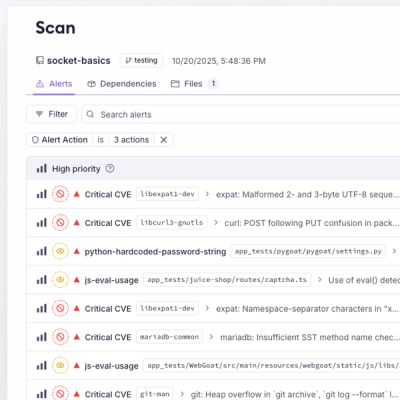
Research
Malicious NuGet Packages Typosquat Nethereum to Exfiltrate Wallet Keys
The Socket Threat Research Team uncovered malicious NuGet packages typosquatting the popular Nethereum project to steal wallet keys.
@reservoir0x/gelato-adapter
Advanced tools
An adapter used to enhance a ethers wallet adapter with the gelato SDK for use in the @reservoir0x/reservoir-sdk to enable gasless transactions
yarn add @reservoir0x/gelato-adapter @reservoir0x/reservoir-sdk
Also make sure to install the peer dependencies required by the adapter if your application doesn't already include them:
yarn add ethers viem @reservoir0x/reservoir-sdk
There are two ways to use this adapter: with a Gelato API key or a Gelato API proxy URL.
If you are relaying transactions for a public protocol like Seaport, you might prefer to use the Gelato SDK on the backend to not expose your API keys as these will give anyone the power to relay their transactions. In this case, you should use the Gelato API proxy URL parameter. You will have to build your own backend API proxy, there is a basic example here.
Otherwise, if you are relaying transactions and don't mind your API keys being public, you can pass the Gelato API keys into the adapter directly on the front-end.
To use the adapter pass in your ethers signer and Gelato API key / Gelato API proxy URL. In return receive a normalized ReservoirWallet object:
sequenceDiagram
actor U as User
box rgba(255, 255, 230, 0.1) API key lives here
participant C as Client
end
participant G as Gelato
U->>C: Click relay
activate C
C->>U: Prompt user to sign data
U->>C: Sign data
deactivate C
C->>G: Request relay with signed data
activate G
G->>C: Return taskId
deactivate G
import { getClient } from '@reservoir0x/reservoir-sdk'
import { adaptGelatoRelayer } from '@reservoir0x/gelato-adapter'
import { useSigner } from 'wagmi'
...
const { data: signer } = useSigner()
const wallet = adaptGelatoRelayer(signer, GELATO_API_KEY)
getClient().actions.buyToken({
items: [
{
collection: '0xbc4ca0eda7647a8ab7c2061c2e118a18a936f13d',
},
],
options: {
usePermit: true,
currency: '0x07865c6e87b9f70255377e024ace6630c1eaa37f', //GOERLI USDC
},
wallet,
onProgress: () => {},
})
You will have to build your own backend API proxy, there is a basic example here.
sequenceDiagram
actor U as User
participant C as Client
box rgba(255, 255, 230, 0.1) API key lives here
participant P as Gelato API proxy
end
participant G as Gelato
U->>C: Click relay
activate C
C->>U: Prompt user to sign data
U->>C: Sign data
deactivate C
C->>P: Send signed data
activate P
P->>G: Request relay with signed data
activate G
G->>P: Return taskId
deactivate G
P->>C: Return taskId
deactivate P
import { getClient } from '@reservoir0x/reservoir-sdk'
import { adaptGelatoRelayer } from '@reservoir0x/gelato-adapter'
import { useSigner } from 'wagmi'
...
const { data: signer } = useSigner()
const apiProxyUrl = "/api/relay"
const wallet = adaptGelatoRelayer(signer, undefined, apiProxyUrl)
getClient().actions.buyToken({
items: [
{
collection: '0xd8560c88d1dc85f9ed05b25878e366c49b68bef9',
},
],
options: {
usePermit: true,
currency: '0x07865c6e87b9f70255377e024ace6630c1eaa37f',
},
wallet,
onProgress: () => {},
})
In the code snippets above we use the wagmi useSigner method, which is not required, you can create your ethers signer however you wish. We then adapt the signer to the ReservoirWallet object and pass this into any of the SDK methods. Here we pass it into the buyToken method along with the other required parameters. In order for the purchase to be successful you'll need the following:
FAQs
An adapter used to enhance a ethers wallet adapter with the gelato SDK for use in the @reservoir0x/reservoir-sdk to enable gasless transactions
The npm package @reservoir0x/gelato-adapter receives a total of 561 weekly downloads. As such, @reservoir0x/gelato-adapter popularity was classified as not popular.
We found that @reservoir0x/gelato-adapter demonstrated a healthy version release cadence and project activity because the last version was released less than a year ago. It has 8 open source maintainers collaborating on the project.
Did you know?

Socket for GitHub automatically highlights issues in each pull request and monitors the health of all your open source dependencies. Discover the contents of your packages and block harmful activity before you install or update your dependencies.

Research
The Socket Threat Research Team uncovered malicious NuGet packages typosquatting the popular Nethereum project to steal wallet keys.

Product
A single platform for static analysis, secrets detection, container scanning, and CVE checks—built on trusted open source tools, ready to run out of the box.

Product
Socket is launching experimental protection for the Hugging Face ecosystem, scanning for malware and malicious payload injections inside model files to prevent silent AI supply chain attacks.